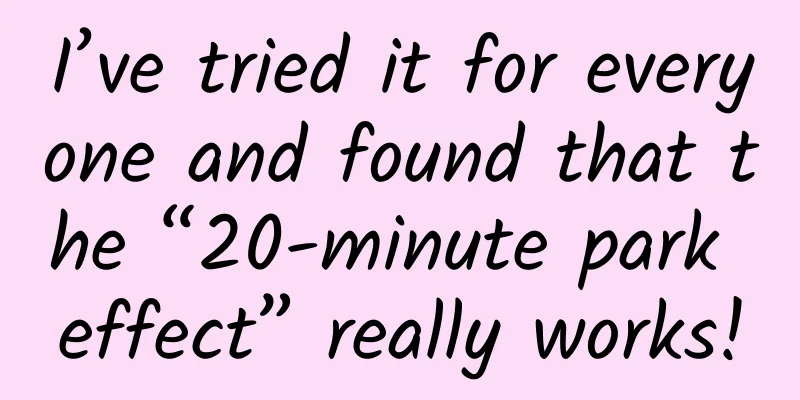I’ve tried it for everyone and found that the “20-minute park effect” really works!

|
I wonder if you have seen the 20-minute park theory recently? It is said that no matter how much negative emotions you have in your heart, you only need to find a park and stay there for twenty minutes doing nothing, and you can instantly recover. Copyright images in the gallery. Reprinting and using them may lead to copyright disputes. This theory originally came from a study published in the International Journal of Environmental Health Research. The study suggests that even if you don't do any exercise, spending 20 minutes in the park can lead to a better state. Yes, even if it's just a simple walk or a little daze, it will have an effect. This theory sounds very mysterious at first, but after research, we found that the 20-minute park theory is not only reliable. We can also start from it and launch a series of fast charging solutions for workers with low time cost, zero money cost, fast effect and no sequelae ! Why is this small city park so magical? Parks are the natural environment that most people can most easily access. Different from the noisy and busy urban buildings and city streets, the green space, streams and unobstructed sky in the park can provide us with a rare piece of nature in the city. The natural environment can bring us many different benefits. 1 Gain health and happiness Many studies have found that people who have more access to natural environments such as parks, woodlands and beaches have better health and happiness. A study conducted in the UK found that people who spent more than 2 hours a week in natural environments had higher health and happiness levels than those who did not have access to nature. This positive effect may be because park environments not only allow people who live indoors for a long time to be exposed to more light, but also make it easier for them to achieve higher levels of physical activity, both of which are beneficial to physical and mental health. 2 Easily reach the minimum level of physical activity in a day Another survey conducted in Beijing found that people who have the habit of visiting parks can achieve the minimum level of physical activity in a day by strolling in the park every day. In addition, the atmosphere of the park environment will make it easier for them to do some simple exercises - after all, parks often have a lot of exercise equipment. Even if you don't join the army of people exercising in the park, it is useful just to sit in the park and daydream . 3 Release negative emotions Many studies on natural environments and stress have found that spending more time in natural environments can significantly reduce stress levels, and the amygdala, which is associated with fear, stress, and pressure, will be less likely to be activated. In other words, parks can not only help us relieve stress, but also make us less likely to generate new stress. In daily life, we travel back and forth between cubicles, living a similar life day after day, which makes it easy for us to lose our perception of the things around us, and we can only pay too much attention to our own emotions, and then fall into continuous negative emotions. When we are in nature without a ceiling, those troubles and pains will become insignificant, and will be blown away by a gust of wind. When negative emotions are cleared, positive emotions will naturally have room to grow. 4 Helps with concentration According to the attention restoration theory proposed by psychologists Kaplan and his wife, doing activities that are in line with our intrinsic motivations and getting some gentle stimulation in an extended space away from our daily living environment can help restore our attention . Parks happen to be the most accessible places around us, and they meet the four major characteristics of being away, extension, compatibility and fascination. Many people don’t care, but in fact, our attention is also a limited resource. When we are in an urban environment, the people, things, and objects around us are almost constantly creating “information noise” that consumes our attention. But parks are rare information blank areas in the city. There is little noise in parks. There is only the rustling of leaves in the wind, the singing of birds on the treetops, and the gurgling of the river. Even if there are occasional human voices, they are just the shouts of the elderly exercising and the laughter of children playing games, and even these sounds will seem very far away after being blocked and absorbed by the green trees. In such a peaceful atmosphere, a feeling of relaxation and comfort comes over us, and it is easier for us to enter a state of mind-free. The brain, which is working at high speed, can take a short break, and the attention resources can finally be accumulated again. Generally speaking, open wilderness is more likely to have extension. However, in a relatively small area, by designing different road features and trails, the small area can also appear larger than the original area, providing a sense of extension. Miniature landscaping can also make people feel like they are in a different world, such as a different scene with each step in a garden. In addition, parks have unexpected "social attributes". In this small social venue, we can break down the interpersonal walls of modern communities and randomly establish some emotional connections with unfamiliar neighbors - casually chatting about family matters, or reaching out to touch the neighbor's cute puppy. These random but surprising interpersonal interactions will also provide us with inner energy. Low-cost human fast charging solution Of course, in addition to parks, there are other low-time and low-money options for contemporary people to quickly recharge their spirits. 1 Look at the sky Have you ever stopped on your way home from get off work and looked up at the sky? Yes, looking up at the sky can also help you feel refreshed. Compared to our unchanging daily life, the weather is a surprise gift package that we can refresh every day. This sense of surprise will bring us full of expectations and pleasure. Copyright images in the gallery. Reprinting and using them may lead to copyright disputes. Moreover, the sky is also an environment with a greater sense of extension than the park. When thoughts drift slowly with the clouds, our spiritual reservoirs are quietly filled up. Simply looking up at the sky for a while, you will find that your fatigue disappears, your mood improves, and even your long-lost concentration and creativity return. 2 Hug a tree As mentioned earlier, activities in natural environments can significantly reduce stress levels. In addition to walking and daydreaming, some people have discovered a more natural way to get back to nature: hugging a tree. That’s right, just find a big and sturdy tree, hug it tightly as if you were hugging a lover, a friend, or a relative, close your eyes, feel the breath of nature, and feel the silent support the tree gives you. 3 Mini Vacation/Short Escape In fact, whether you are visiting a park, looking at the sky or hugging a tree, the same logic is hidden behind it - a short escape. Short escape is a concept derived from vacation. Vacation may have many restrictions, such as time cost, money cost and even miscellaneous things at home. But what if you just escape from your daily life for a short time and take a vacation of only one day or even a few hours? What we call a micro-vacation/short escape actually emphasizes breaking out of the daily life pattern and achieving a mental state of vacationing anywhere by changing the environment or activity pattern. To achieve the purpose of a "micro-vacation/short escape", only two principles are needed: either change the environment or do something else . For example, if we usually stay indoors, we should try to go outdoors. Parks and the wild are good, but green spaces in communities, safe urban green belts, and other places can also have good effects. It would be easier to do something else, such as trying carpentry or assembling a cabinet by yourself. Any behavior pattern that is different from daily life will bring a sense of healing. In short, boldly trying to do different things in different environments can really bring new experiences to both the body and mind! References [1]White, MP, Alcock, I., Grellier, J. et al. Spending at least 120 minutes a week in nature is associated with good health and wellbeing. Sci Rep 9, 7730 (2019). [2]Jimenez, MP, DeVille, NV, Elliott, EG, Schiff, JE, Wilt, GE, Hart, JE, & James, P. (2021). Associations between Nature Exposure and Health: A Review of the Evidence. International journal of environmental research and public health, 18(9), 4790. [3]Liu, H., Li, F., Li, J., & Zhang, Y. (2017). The relationships between urban parks, residents' physical activity, and mental health benefits: A case study from Beijing, China. Journal of environmental management, 190, 223-230. [4]McMahan, EA, & Estes, D. (2015). The effect of contact with natural environments on positive and negative affect: A meta-analysis. The Journal of Positive Psychology, 10(6), 507–519. [5]Wang, X., Rodiek, S., Wu, C., Chen, Y., & Li, Y. (2016). Stress recovery and restorative effects of viewing different urban park scenes in Shanghai, China. Urban forestry & urban greening, 15, 112-122. [6]Grahn, P., & Stigsdotter, UA (2003). Landscape planning and stress. Urban forestry & urban greening, 2(1), 1-18. [7]Ohly, H., White, MP, Wheeler, BW, Bethel, A., Ukoumunne, OC, Nikolaou, V., & Garside, R. (2016). Attention Restoration Theory: A systematic review of the attention restoration potential of exposure to natural environments. Journal of Toxicology and Environmental Health, Part B, 19(7), 305-343. [8]Kaźmierczak, A. (2013). The contribution of local parks to neighborhood social ties. Landscape and urban planning, 109(1), 31-44. Planning and production Author: Science Popularization Team of Xinshi Science Popularization Studio Reviewer: Zhang Xin, Associate Professor, School of Psychology and Cognitive Science, Peking University Planning丨Yinuo Editor: Yinuo Proofread by Xu Lai and Lin Lin |
<<: The "Roof of Europe" - Mount Etna has recently become popular again!
Recommend
This year's Nobel Prize in Chemistry is finally not a science award!
This article was first published by Hunzhi (WeCha...
Lu Jing: Searching for "bones" and exploring the present to live up to the passion
She traces the past and explores the future in th...
If a child suffers from "skin hunger syndrome", can the condition be cured by parents hugging him/her frequently?
gossip “Is ‘skin hunger’ a disease that needs tre...
IC Insights: Capital expenditures for the entire semiconductor industry are forecast to be around $146.6 billion in 2023, down 19% year-on-year
Memory chip manufacturers, including Micron and S...
Neijiang Mini Program Agency Company, how much does it cost to be an agent for aquatic products mini program?
How much does it cost to be an agent for a fisher...
Gu Mu's resume: The difference between black hat and white hat techniques in SEO optimization
As the name suggests, white hat SEO optimization ...
How to create a CocoaPods in Swift
You may be familiar with some well-known open sou...
Eating colleagues with big mouths? Pelican, why do you stuff everything into your mouth?
Recently, a pelican in a theme park in Xi'an ...
Information flow advertising | Double 11 is coming, take the 12 sets of e-commerce materials with the best conversion for free!
Double 11 is coming, and it’s time to spend money...
How the expansion of mobile screen size affects user experience design
The era of small-screen phones with various shape...
Why does Xiaomi make air purifiers?
A few days ago, Lei Jun announced on his Weibo th...
Toyota adjusts car/light truck production ratio to light trucks
According to a US media report on November 28, To...
How to increase the landing page conversion rate from 13% to 30%?
I have read some articles about how to improve th...
Mobile apps are getting bigger and bigger. It's time to say goodbye to 64G mobile phones
Many people are paying attention to 5G network sp...
What is the brushed cloud? Clouds have names, and if you don't know them, the clouds will be sad!
Clouds are a testimony to the beauty of the world...









